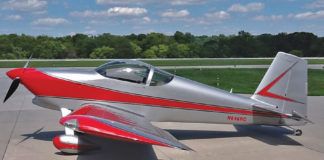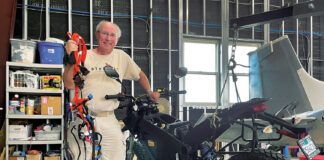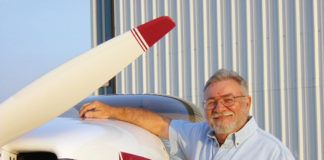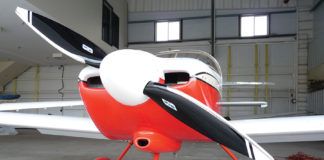Almost all airplanes have separate controls for all three axes. The elevator controls pitch, the ailerons control roll, and the rudder controls yaw. Typically, the elevator is a true single-axis control, where a control input only affects pitch. In general, roll and yaw are coupled by several phenomena. Most ailerons produce some adverse yaw, so a lateral stick input intended to roll the airplane will produce some yaw. In the yaw axis, most airplanes have some stable dihedral effect, which produces yaw/roll coupling. A rudder input intended to command sideslip will also cause the airplane to roll in the same direction as the nose moves in response to the rudder.
To maneuver the airplane, the pilot must coordinate inputs to all three controls. Airplanes turn by banking to direct some of the lift of the wing to the inside of the turn. This lateral component of the lift curves the flight path, and the turn is initiated with a roll input to the stick. Some rudder is needed to counter the adverse yaw of the ailerons and keep the turn coordinated. At the same time, the pilot must put some back pressure into the stick to increase the angle of attack and generate the extra lift needed to turn the airplane while maintaining a constant altitude.
A significant portion of early pilot training is devoted to learning how to properly coordinate the three controls. Over the years, there have been many attempts to devise two-control airplanes to make the pilot’s job a little simpler. All of these two-control schemes are designed to allow the pilot to exercise lateral/directional control with a single control input that replaces the coordinated stick and rudder inputs used in conventional airplanes. Three general approaches have been tried.
Aileron/Rudder Interconnect
An aileron/rudder interconnect (ARI) is a control linkage that couples the ailerons and rudder. When the stick (or yoke) is moved laterally, the ailerons and rudder both move. With proper design, the movement of the rudder is sufficient to counter the adverse yaw of the ailerons and generate a coordinated roll into or out of a turn.
The most successful two-control airplane (in terms of production numbers) is the Ercoupe, which uses an ARI and has shown it can provide quite acceptable control in the air. Another example of an airplane with this type of control setup is the twin-boom Anderson-Greenwood AG-14 pusher.
The primary disadvantage of a two-control airplane with coupled ailerons and rudder is that the pilot has no independent way of controlling yaw or commanding sideslip. This becomes an issue on the runway and in crosswinds.
In the air, turns are coordinated, and the roll axis is most important in maneuvering. On the ground, the airplane must be controlled in yaw to taxi and to track the runway centerline on takeoff and landing. The Ercoupe and the AG-14 both have tricycle landing gear with steerable nosewheels. The nosewheel steering is coupled to the yoke, so what would be a roll input to a pilot trained on a conventional airplane becomes a yaw steering input on the ground. This works, but it does require a different technique than a conventional airplane. To maintain directional control, the pilot must keep the nosewheel firmly on the ground. Lifting or lightening the nose with back pressure on takeoff is not a good idea.
Crosswinds present a different challenge. A crosswind landing in a conventional airplane involves using the rudder to keep the axis of the airplane aligned with the runway, and bank angle to keep the airplane from drifting laterally with the wind. Both the “kick-out” and “steady slip” methods of crosswind landing require uncoordinated rudder and aileron inputs to command a sideslip at touchdown.
But a two-control airplane does not give the pilot the ability to command a steady-state sideslip. Accordingly, the nose of the airplane is always aimed directly in the direction of the airplane’s travel through the air. In a crosswind landing, the pilot must fly with the nose aimed somewhat into the wind to keep the airplane’s ground track aligned with the runway. There is no way to decouple the airplane’s heading from its flight path, so it will touch down yawed relative to the runway. This will produce a large side force on the main landing gear and a downwind yaw as the airplane aligns itself with the runway after touchdown. The pilot must lower the nosewheel quickly to establish directional control after touchdown. Given stout landing gear and proper pilot technique, this is all possible, as Ercoupe pilots prove, but it is significantly different from what a pilot trained on “normal” controls would do.
Crosswind takeoffs also require a different technique. During a crosswind takeoff, the airplane directional stability causes it to try to yaw into the wind. At the same time, the dihedral effect of the wings causes it to try to roll downwind. With conventional controls, the pilot counters these tendencies by deflecting the ailerons to roll the airplane toward the wind, and the rudder to yaw the airplane away from the wind. This is an uncoordinated input that is not possible on a two-control airplane. A downwind steering input will cause the upwind wing to rise, and an upwind roll input will cause the airplane to yaw into the wind. The solution is to keep the nose firmly planted so that the nosewheel has enough traction to resist the upwind yawing moment and keep the control neutral to avoid any unwanted downwind rolling moment.
All of these crosswind considerations require that the landing gear of a two-control airplane be stronger and more stable than that of a conventional airplane.
Rudder Only: No Ailerons
A second approach to a two-control scheme is to eliminate the ailerons and control the lateral/directional axes entirely with rudder. This concept was used on the Flying Flea and many ultralights. The key to making this approach work is to give the wing enough dihedral so that there is a strong coupling between roll and yaw. To turn, the pilot yaws the airplane with the rudder, and the dihedral effect causes the airplane to roll in the direction of the turn. Sufficient dihedral effect is vital, because when flying up and away, the pilot must be able to control the airplane in roll to keep it upright, and to maneuver.
A rudder-only airplane differs from an ARI airplane in that the entry and exit from turns is uncoordinated. To get the airplane to roll, the rudder must command enough sideslip so that the wing dihedral generates the required rolling moment. On entry to the turn, the airplane will be skidding, and on exit, it will be slipping. Some pilots find this disconcerting, but apparently they get used to it.
A rudder-only airplane has the same crosswind issues as an ARI airplane. There is an additional concern with rudder-only airplanes. To be controllable, a rudder-only airplane must have more dihedral than a conventional airplane. While this improves spiral stability, it reduces damping of Dutch roll. A rudder-only airplane is likely to exhibit more lateral/directional motion in turbulence.
There is a difference of opinion among designers about the pilot’s controls on rudder-only airplanes. Some designers choose to eliminate the rudder pedals and have lateral motion of the stick move the rudder; the Flying Flea used this approach. Others eliminate the lateral motion of the stick, and have the rudder controlled by rudder pedals like a conventional airplane. Mike Sandlin uses this approach on his Pig glider and Bloop “motorfloater” ultralight. Both approaches work, though both require the pilot to adapt somewhat from a conventional airplane.
Ailerons Only: No Rudder
A two-control approach that is common in the radio-controlled model world is to use ailerons to control roll and eliminate the rudder. To make this work, the ailerons must be designed to minimize adverse yaw, and the airplane must have sufficient directional stability so that it does not need rudder inputs to coordinate.
At least one light airplane, the 1941 General Aircraft Skyfarer, used this approach. It flew successfully, and a few were built before the General factory was converted over to building CG-4 gliders for the war effort.
An ailerons-only airplane, like the rudder-only airplane, will be somewhat uncoordinated during turn entries and exits. The direction of the “uncoordination” is reversed from the rudder-only airplane. The ailerons-only airplane will slip on turn entry and skid on turn exit.

On the Ercoupe, twin fins are mounted on the ends of the horizontal tail to move them out of the prop’s slipstream and eliminate most of the P-factor.
P-factor
An issue for ARI airplanes and ailerons-only airplanes is that the pilot cannot deflect the rudder to counter P-factor during climb. The solution chosen on the Ercoupe, the AG-14 and the Skyfarer was to use twin fins mounted on the ends of the horizontal tail. This moves the fins out of the spiraling slipstream of the propeller and eliminates the majority of the P-factor.
The idea of a two-control airplane to simplify flying comes and goes. Enough successful two-control airplanes have been built to show that it is a valid approach to creating a viable light airplane. History seems to show that the dream of simplified flight instruction and simpler flying will not be fulfilled just by eliminating the rudder pedals. Pilots trained on conventional controls generally do not like the loss of independent control of all three axes, and a large number of Ercoupes have been converted to three-control airplanes. Ultralighters seem to be more accepting of two-control designs, and it appears that there will always be a niche for them.

![]()
Barnaby Wainfan is a principal aerodynamics engineer for Northrop Grumman’s Advanced Design organization. A private pilot with single engine and glider ratings, Barnaby has been involved in the design of unconventional airplanes including canards, joined wings, flying wings and some too strange to fall into any known category.













